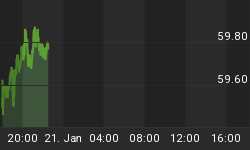Consumer prices rose 0.1% in February, which was inline with economists' forecasts. Energy prices declined by 1.2% and apparel priced dropped by a full percent. On a year-over-year basis, consumer prices rose 3.6% and the core rate was 2.1% higher than last year. The largest component of CPI (23.4% weighting) is owner's equivalent rent, which is supposed to capture the increase in housing costs. According to the government, the cost of housing has increased only 2.5% from last year. Considering that the method the government uses to calculate housing cost is specious, looking at the inflation excluding the calculation can be beneficial. Although it is not widely discussed, the Labor Department publishes the CPI excluding shelter. While it dropped in February both sequentially and year-over-year, it is 4.2% higher than last year and has been over 4% for six of the past seven months. Prior to August 2005, there had been only four months since 1992 that it was over 4%. The producer prices index left economists scratching their head. The headline number dropped 1.4%, which was significantly lower than in January (0.3%) and the 0.2% drop economists were expecting. While the headline number dropped, excluding energy and food, producer prices rose 0.3% from January and 1.7% from a year ago. Both were higher than economists forecasted.
Housing starts dropped 8% from the thirty-three year high set in January. While this was lower than last month, the 2.12 million homes started were higher than the 2.03 homes that economists predicted. Building permits also dropped in January. There were 2.145 million permits issued in February compared to 2.216 million in January, but slightly higher than the 2.11 million expected.
KB Home reported first quarter results on Wednesday. Homebuilding revenue increased 35%, which was split between units up 15% and pricing up 17%. Gross orders were flat, but net new orders declined 12%, due to "higher cancellation rates, which rose to more normalized levels, adversely impacted our net order comparison in the first quarter." There was a 24% increase in backlog with unit backlog growing only 13.7%. These were the slowest growth rates since the first quarter of 2003. The average price of a house in backlog increased 9.6%; this was the slowest growth since the third quarter of 2004.
Federal Express reported third quarter earnings that were above analysts' estimates. Net income rose 35% on a 9% increase in sales. The second-largest shipping company raised prices 5.5%. The company expects the economy to grow 3.2% during its fiscal 2007 year, which starts in June. The company also noted that the Japanese economy showed signs of improvement.
Dollar General reported fourth quarter earnings per share that was about four cents lower than analysts' estimates. We have discussed how lower income consumers have been challenged by the current state of the economy. Dollar General's results were indicative of this and that the fourth quarter "was difficult for all retailers serving the lower income customer." Furthermore, management added that "the highly promotional activities seem to me an attempt by other retailers to combat what was indeed an overall weakness in the sector." Because of the higher promotional activity, gross margins declined by 56 basis points to 29.5%. The company also guided analysts to lower earnings for the current quarter. The lower results will be caused by the continued promotional activity that is pressuring gross margins and increasing advertising costs.
Wal-Mart has been trying to go more upscale. Its latest new store, here in the Dallas area, targets more affluent shoppers. The store is across the street from a mall that contains Neiman Marcus and Saks Fifth Avenue. According to the 2000 Census, the median family income for the zip code of the store location was $124,851 in 1999. While this store might flourish , it has a significantly different customer base than the vast majority of its other stores. Even if Wal-Mart rolls out higher end products to its other stores it will have negligible impact for several years, but will likely be disruptive to its competitors.
Last week, Steve Liesman, economics reporter for CNBC, said that a Fed official (either unnamed or I didn't catch the name) said that as soon as the economy looked like the economy of the mid-1990s, the fed would increase rates to the level of the mid-1990s. The table below details the major economic statistics from the mid-1990s along with the most recent data point.
| 1994 | 1995 | 1996 | 1997 | Average | Most Recent | |
| Fed Funds | 5.5% | 5.5% | 5.25% | 5.5% | 5.4% | 4.5% |
| CPI | 2.7% | 2.5% | 3.3% | 1.7% | 2.6% | 3.6% |
| CPI - core | 2.6% | 3.0% | 2.6% | 2.2% | 2.6% | 2.1% |
| PCE | 2.3% | 1.9% | 2.4% | 1.1% | 1.9% | 3.1% |
| PCE - core | 2.4% | 2.1% | 1.8% | 1.4% | 1.9% | 1.8% |
| GDP real | 4.0% | 2.5% | 3.7% | 4.5% | 3.7% | 3.2% |
| GDP cur$ | 6.2% | 4.6% | 5.7% | 6.2% | 5.7% | 6.4% |
| Unemployment rate | 5.5% | 5.6% | 5.4% | 4.7% | 5.3% | 4.8% |
| M3 Growth | 2.0% | 6.1% | 7.5% | 9.5% | 6.3% | 8.1% |
From the table above it should be clear the only economic data that is significantly different than that of the mid-1990s are the core rates of inflation. In fact, several of the data items would suggest that the economy is stronger than it was in the mid-1990s and rates need to move higher than they were back then. At the least, the target rate should be 100 basis points higher.
















